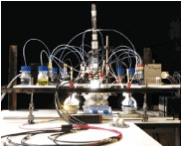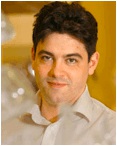The 81st Joseph Henry Lecture
Synthesizing Life
Lee Cronin
Gardiner Professor of Chemistry
University of Glasgow
Sponsored by Millen, White, Zelano & Branigan, PC
About the Lecture

What is life? How did life start on planet earth 3.5 billion years ago? Which molecules and chemical systems led to biology? Is biology limited to the carbon-based chemical systems of life as we know it or can other chemical systems support other biologies? Is there a general theory of evolution that extends to all matter? These are fantastically interesting questions fundamental to our understanding of life itself. This lecture will explore answers to these questions – by looking to the future rather than by looking to the past. Invoking the concept of ‘adaptive matter’ composed of evolvable chemical systems and materials the lecture will address the fundamental question of biology: “What is the minimal chemical system that can undergo Darwinian evolution?” It will do so not only conceptually but empirically. It will discuss how chemists can attempt to create new types of biology, truly synthetic life. In particular, it will describe experiments to create inorganic biology: living systems that do not use proteins, DNA or sugars. The lecture will describe the chemistry, materials, and novel reactor arrays now being used to carry out these experiments. including a network reactor array the speaker constructed in his Glasgow laboratory that, he hopes, will enable his research group to create autonomous chemical entities capable of replication and adaptive behavior.
About the Speaker

LEE CRONIN is Gardiner Professor of Chemistry at the University of Glasgow. His work focuses on understanding and controlling self-assembly and self-organization in chemical systems. His group is working to develop functional molecular and nano-molecular chemical systems, linking architectural design with function to engineer system-level functions such as coupled catalytic self-assembly and the fabrication of inorganic cells thatallow complex cooperative behaviors. He also works on 3D printing wetfabs, drug development, sensors and fuel cells. Cronin and his group pursue their research through a wide range of international collaborations. Cronin earned his BSc and PhD in Chemistry at York University, was an Alexander von Humboldt Fellow at Birmingham University, held appointments as Lecturer, Reader and Professor and was an EPSRC Advanced Research Fellow at the University of Glasgow before assuming the Gardiner Chair of Chemistry. He has published more than 200 papers in professional journals and has given over 150 invited talks all over the world, including the keynote talk at TED Global 2011. Among many honors and awards, Cronin is the recipient of the Hay Lectureship, the Leverhulme Prize, the Morino Foundation Prize, and the Royal Society’s Wolfson Award. He is a member of numerous honorary organizations and is a Fellow of the Royal Society of Edinburgh.
Minutes
President John Ingersoll called the 2,302nd meeting to order at 8:37 pm May 25, 2012 in the Powell Auditorium of the Cosmos Club. Mr. Ingersoll announced the order of business and introduced one member of the Society, the speaker of the evening.
The minutes of the 2,301st meeting were read and approved.
Mr. Ingersoll then introduced the speaker, Mr. Lee Cronin of the University of Glasgow. Mr. Cronin spoke on "Synthesizing Life."
Mr. Cronin began by discussing the definition of life and the practical and ethical implications of attempting to synthesize it in lab. He noted that chemists design and create molecules, but evolution is a fundamental driving force in our scientific reality. A new way of doing chemistry that uses evolution with a well-controlled specification in addition to design could help expand the definition of evolution from biology to include inorganic chemistry, focusing on basic cell-like units of matter.
Mr. Cronin wondered if all matter had the potential to evolve and if chemists could make open platforms for synthetic life, engineering or discover non-biological systems capable of evolution. To do so would require minimal chemical units capable of autonomous assembly, adaptation, selection, and propagation. This calls into question the very definition and traits of "life," which Mr. Cronin considers to be a reaction network of many interconnected simultaneous chemical processes.
It is important to consider the Earth's timeline for the formation of early life, he said. The Earth is approximately 4.5 billion years old and we believe life arose 4 billion years ago, so understanding the transition from inorganic to organic chemistry that must have happened in that first 500 million years is the quest of Mr. Cronin's research. It has been suggested that life in general is fantastically improbable given the easily calculated low probability of producing complex organic molecules from random processes, but he strongly believes that evolutionary processes for inorganic molecules such as molybdenum may have given rise to the level of order required for biology to emerge.
Mr. Cronin acknowledges that there is a vast literature of primordial chemistry related to carbon-based life, but he believes the emergence of life was much faster than commonly assumed and the time scales associated with carbon require that the conditions must have been ideal for the first living system. His research involves doing laboratory work on the scale of hours to screen and select the various possibilities that may have originally taken a hundred million years. It also is commonly thought amongst biologists that all life on Earth shared a common ancestor, but that may not be required if the convergence to our biology was the perfect expression of the chemistry availability when life was emerging.
Mr. Cronin then defined a Minimal Darwinian Evolutionary system which contains objects that replicate with optional mutation and offspring that compete in the environment to persist or die. The mutation may be copied during replication, a process that allows the system to accumulate information. He suggested that life is better defined by the ability to evolve and that is possible to engineer an evolving system in the laboratory with designed molecules and competition inspired by biology.
Mr. Cronin's research involves building bridges between chemistry and biology, using molybdenum oxide chemical networks to explain the transition from non-life to simple life which laid the ground work for more complex biological processes. He believes this emergence of chemical networks and evolution were part of a single continuous process in Earth's early timeline.
Mr. Cronin explained that two complementary molecules can make perfect copies but replication that allows errors is key for the evolution to be considered life. Many small building blocks based on molybdenum oxide can be used to construct a large variety of nano-size molecules that can be chemically converted in a Darwinian way. Evolution can be performed top-down using artificial selection by the chemist or by an evolutionary algorithm in a fully computer computer controlled experiment, but Mr. Cronin has attempted to create bottom-up evolution by embedding multiple inorganic molecular networks.
Mr. Cronin demonstrated a series of molecules that grow to a larger, more complicated version when remixed with the basic chemical building blocks. As a function of time, this system is analogous to an inorganic phylogenetic tree. Specifically, when these molecules are placed at a water interface they form containers similar to cells, which can then contain reactions such as minimal photosystems that change the cell's color as a function of the metabolism to provide competition.
Mr. Cronin then described several ongoing experiments in his research group. The first combines multiple flasks with interconnected reactions containing the appropriate chemical building blocks with the goal of engineering a molecular network that replicates in 5000 hours. The second revisits Miller and Urey's 1953 experiment with the addition of phosphate, calcium hydroxide, silica, and iron pyrite with precise computer control. Finally, passing inorganic chemical cells through custom microfluidic devices allows them to be split in half and recombined in a manner analogous to DNA.
Mr. Cronin concluded by stating that his universal definition of life is matter than evolves under a general theory of evolution, a shift from selfish gene to selfish matter. He believes the earliest life began as inorganic matter, minimal cells, proteins, then RNA, DNA, and our ancestors. His ongoing research is focused on the minimal chemistry set in the periodic table that allows the formation of sophisticated molecules that can compete and evolve, demonstrating the creation of inorganic life.
With that, he closed his talk and Mr. Ingersoll invited questions.
Someone wondered how the metabolism requirement was fulfilled by the inorganic cells. Mr. Cronin explained that the cells absorb light by splitting water and storing electrons, turning blue in the process. These stored electrons can later be used to do work inside the cell.
Another question concerned the nature of modern human evolution. Mr. Cronin believes that modern society has altered the fitness function for humanity such that the evolutionary course has been modified in ways that are now much harder to predict.
After the question and answer period, Mr. Ingersoll thanked the speaker, made the usual housekeeping announcements, and invited guests to apply for membership. At 10:23 pm, President John Ingersoll adjourned the 2,302nd meeting to the social hour.
Attendance: 109
The weather: Clear
The temperature: 19°C
Respectfully submitted,
Justin Stimatze,
Recording secretary